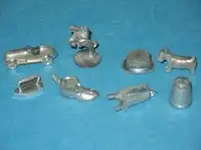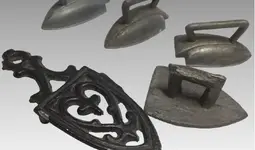FieldStone
Jr. Member
- Joined
- Jan 9, 2019
- Messages
- 53
- Reaction score
- 238
- Golden Thread
- 0
- Location
- New England
- 🏆 Honorable Mentions:
- 1
- Detector(s) used
- Equinox 800
Fisher F2
- Primary Interest:
- All Treasure Hunting
Fellow Diggers, I am looking for some help with ID’ing this item found at a 1700’s colonial cellar hole. Yes, it’s a small flat iron, but is it an actual iron for pleats, a toy, or something from a dollhouse? It is made from Pewter, weighs 26.3 grams, and appears to have been cast as you can see the seam below the handle. ( yes its cast crooked as shown in the photos)
I have contacted the Pressing Iron & Trivets Collectors of America, the Great Dollhouse Museum of America, the Antique Toy Collectors of America, and an Antique Dealer in CA who sells lots of flat irons. No one has any information on what exactly this is.
I have searched for the last day and a half (perks of being an IT Manager) about colonial toys, toys from the 1800’s and have come up with nothing. While searching about dollhouses, I came across the following ( which may support the very fancy button ( $ ) found just a few feet away):
In the beginning, dollhouses had only two purposes: display and pedagogy. First built in the 17th century in northern Europe, primarily in Germany, Holland, and England, dollhouses were designed for adults. They were closely associated with wealth and served as markers of social class and status. As Faith Eaton explains in The Ultimate Dolls House Book, the German word dockenhaus meant not dollhouse but “miniature house.” And a miniature house was not a house to play with. In Holland, these exhibits of wealth were called “cabinet houses.” The front of the house opens like a china cabinet on hinges that can be closed and locked. Inside cabinet houses, people could both show off and conceal their collections of expensive miniature objects.
Beginning in the 17th century, “Nuremberg kitchens” might contain a hearth, cooking pots, a straw broom. These all-metal houses were designed without ornament, for purely utilitarian purposes. Used as teaching tools for girls, Nuremberg kitchens allowed mothers to show daughters how to set up and control a house. All about learning rules, a Nuremberg kitchen was the opposite of a dollhouse as a dream world of fantasy. It was a place where girls learned to manage not only the objects of the house but also its servants, where girls would learn to become the lady of the house.
Does anyone have any idea on what this may be from, or could direct me to someone who might have some further information? Please?
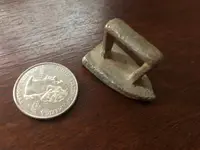
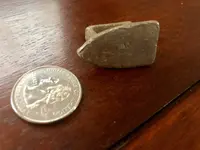
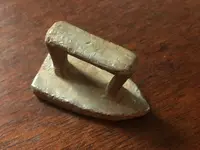
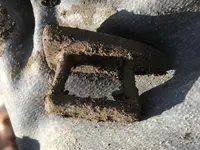
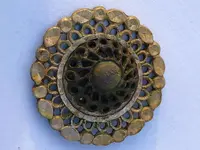
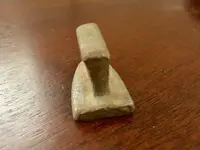
I have contacted the Pressing Iron & Trivets Collectors of America, the Great Dollhouse Museum of America, the Antique Toy Collectors of America, and an Antique Dealer in CA who sells lots of flat irons. No one has any information on what exactly this is.
I have searched for the last day and a half (perks of being an IT Manager) about colonial toys, toys from the 1800’s and have come up with nothing. While searching about dollhouses, I came across the following ( which may support the very fancy button ( $ ) found just a few feet away):
In the beginning, dollhouses had only two purposes: display and pedagogy. First built in the 17th century in northern Europe, primarily in Germany, Holland, and England, dollhouses were designed for adults. They were closely associated with wealth and served as markers of social class and status. As Faith Eaton explains in The Ultimate Dolls House Book, the German word dockenhaus meant not dollhouse but “miniature house.” And a miniature house was not a house to play with. In Holland, these exhibits of wealth were called “cabinet houses.” The front of the house opens like a china cabinet on hinges that can be closed and locked. Inside cabinet houses, people could both show off and conceal their collections of expensive miniature objects.
Beginning in the 17th century, “Nuremberg kitchens” might contain a hearth, cooking pots, a straw broom. These all-metal houses were designed without ornament, for purely utilitarian purposes. Used as teaching tools for girls, Nuremberg kitchens allowed mothers to show daughters how to set up and control a house. All about learning rules, a Nuremberg kitchen was the opposite of a dollhouse as a dream world of fantasy. It was a place where girls learned to manage not only the objects of the house but also its servants, where girls would learn to become the lady of the house.
Does anyone have any idea on what this may be from, or could direct me to someone who might have some further information? Please?






Amazon Forum Fav 👍
Upvote
12



